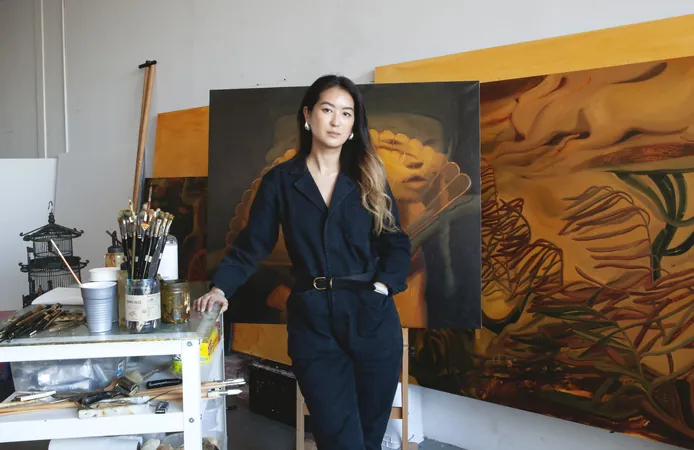
Dominique Fung's Hong Kong Debut: A Journey Through Ancestral History and Identity
2025-04-02
Author: Ming
Introduction
In the vibrant world of contemporary art, Dominique Fung stands out as an artist whose creations bridge the realms of ancient history and modern interpretation. Her debut exhibition in Hong Kong, titled “Beneath the Golden Canopy,” hosted by MASSIMODECARLO, showcases her unique vision, intertwining ancestral imagery with contemporary aesthetics. Each canvas is alive with symbols that resonate deeply, pulsating with a dreamlike quality that blurs the lines of time and space.
Significance of the Exhibition
This exhibition is particularly significant for Fung, marking her first visit back to Hong Kong in over eight years and diving into the roots of her family's heritage. Growing up in Ottawa to parents from Hong Kong and China, her experiences have shaped a narrative that is both personal and universal. In an ideal world, she hoped to return for her grandmother's 90th birthday in 2020, but the pandemic disrupted those plans. However, this slow return to her family's origins has fueled her burgeoning artistic career, where her paintings now fetch six-figure sums at auction and consistently attract attention with sold-out shows.
Emotional Connection and Family Legacy
During the exhibition walkthrough, Fung highlighted the emotional depth behind her work, sharing that she just came from a family reunion lunch with her grandmother, parents, and numerous aunts. This connection with her matriarchal lineage serves as an essential backdrop for the exhibition, infusing her art with layers of intimacy and reminiscence. "My grandmother had seven daughters," Fung mentioned, emphasizing the strength of women that lies at the heart of her family legacy.
Inspiration from Historical Figures
Diving deeper into her explorations, Fung has drawn inspiration from the complex legacy of Empress Dowager Cixi, who wielded power over the Qing dynasty from 1861 until her death in 1908. Western interpretations of Cixi often label her as manipulative, while Chinese narratives can be more intricate. Fung utilizes Cixi's controversial figure not just to tell her story but to also probe broader themes of femininity, power, and the often-ignored roles women have played throughout history.
Artistic Technique and Themes
Her latest series features dynamic compositions that evoke the essence of traditional Chinese scrolls, merging fantasy with history in a mesmerizing manner. As the viewer delves into her canvases, mythical figures such as concubines and emperors emerge, their narratives layered beneath the paint in a visceral interaction of imagery. This method emphasizes a dialogue between past and present, focusing on the fluidity of memory and the fluid identities women possess throughout time.
Symbolism and Power Dynamics
In one of the striking pieces, a dragon—often symbolizing masculine power—fades into a backdrop, while a phoenix radiates strength. This contrast symbolizes the shifting nature of power over time, especially as Cixi's reign saw traditional symbols of masculinity transformed under her influence. Fung's revelations about her artistic process illustrate her instinctual approach to painting; she allows the narratives to unfold organically, crafting an environment where meaning reveals itself gradually, inviting viewers to engage in a visual dance of discovery.
Intimate Space and Historical Echoes
The exhibition also features an intimate space, which Fung envisioned as reflecting Cixi’s private quarters. Here, antique wooden boxes shelter mini masterpieces—delicate gestures that evoke memories and emotions. Fung's meticulous choice of materials serves to enhance the dialogue between the new works and historical artifacts, crafting a conversation that echoes across generations.
Conclusion: Art as a Medium for Healing
Fung's dreamlike paintings not only invite exploration into her familial past but also challenge viewers to confront broader themes of longing and belonging. By addressing the complexities of gender dynamics and ancestral connections, she provides a poignant commentary on the interplay of history and personal identity. Ultimately, her work acts as a portal, inviting reflection on shared human experiences and the enduring legacy of our ancestors. As art becomes a medium for healing and understanding, Fung’s evocative creations illuminate the themes of rebirth and rediscovery, making her debut a significant moment not just for her but for the art world at large.


 Brasil (PT)
Brasil (PT)
 Canada (EN)
Canada (EN)
 Chile (ES)
Chile (ES)
 Česko (CS)
Česko (CS)
 대한민국 (KO)
대한민국 (KO)
 España (ES)
España (ES)
 France (FR)
France (FR)
 Hong Kong (EN)
Hong Kong (EN)
 Italia (IT)
Italia (IT)
 日本 (JA)
日本 (JA)
 Magyarország (HU)
Magyarország (HU)
 Norge (NO)
Norge (NO)
 Polska (PL)
Polska (PL)
 Schweiz (DE)
Schweiz (DE)
 Singapore (EN)
Singapore (EN)
 Sverige (SV)
Sverige (SV)
 Suomi (FI)
Suomi (FI)
 Türkiye (TR)
Türkiye (TR)
 الإمارات العربية المتحدة (AR)
الإمارات العربية المتحدة (AR)